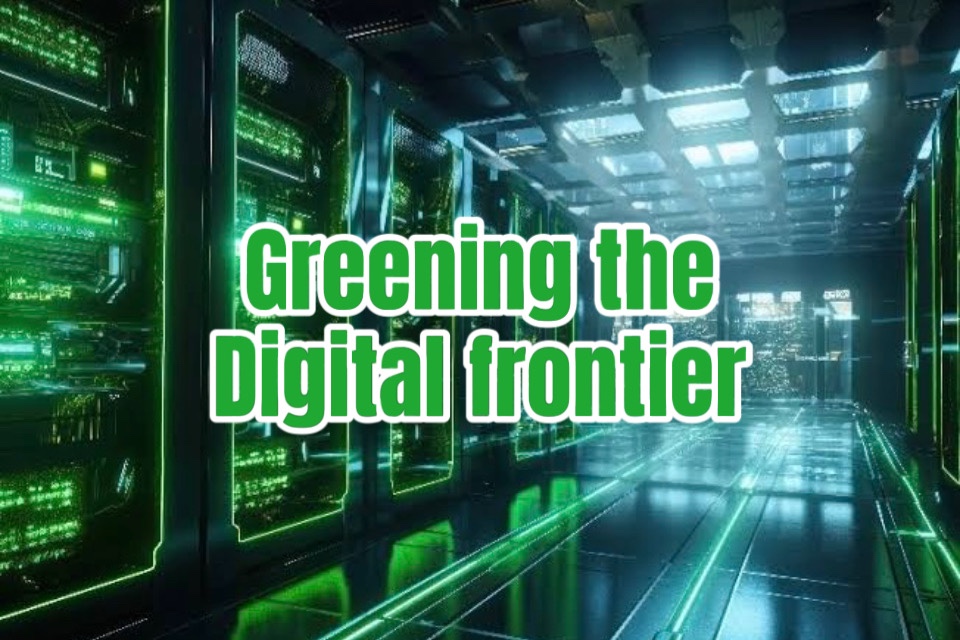
Introduction
In an era they defined by rapid technological in advancement that digital landscape has become an indispensable part of the lives in powering everything from global communications to be intricate financial systems. This omnipresent convenience comes at a significant environmental cost. The energy consumption of IT infrastructure and the burgeoning mountains of electronic waste and the carbon footprint of data centers are pressing concerns that demand immediate attention. Green computing is also known as the sustainable IT in emerges as a critical paradigm and advocating for the environmentally responsible practices throughout the entire in lifecycle of computing systems that from design and to manufacturing is use and disposal. It’s a holistic approach that seeks to minimize the ecological impact of technology while maximizing its efficiency and economic viability.
The Environmental Footprint of IT

The scale of IT environmental impact is an often underestimated. The Data centers are unseen powerhouses of the digital world and consume the vast amounts of electricity and much of which is still generated from the non-renewable sources and contributing significantly to greenhouse gas emissions. Beyond energy the manufacturing of the electronic devices that requires considerable natural resources and often involves hazardous materials. The rapid obsolescence of an technology also fuels the ever growing problem of electronic waste and a toxic cocktail of heavy metals and chemicals that poses serious threats to human health and ecosystems if not managed properly. Addressing this footprint is no longer a niche concern but a global imperative.
Strategies for Sustainable IT Infrastructure
Building a truly sustainable in IT infrastructure that requires a multi faceted approach in it. The Key strategies includes are:
- Virtualization and Cloud Computing: Consolidating the workloads are onto fewer physical servers through virtualization significantly reduces energy that consumption and hardware requirements. Cloud computing by the leveraging shared in optimized data center resources that further amplifies these benefits.
- Energy Efficient Hardware: Opting for hardware designed for the low power consumption like such as energy efficient CPUs and servers and peripherals that is fundamental. Features like dynamic power management that adjust consumption is based on workload can yield substantial savings.
- Optimized Data Storage: Efficient data that storage solutions is including in data de duplication and tiered storage and reduce the need for excessive hardware and associated energy.
Energy Efficiency in Data Centers
Data centers are the epicenters of an IT energy consumption. Achieving energy efficiency in these are facilities is paramount. This is involves:
- Advanced Cooling Systems: The Implementing efficient is cooling technologies that like hot/cold aisle containment and liquid cooling and free air cooling (utilizing ambient air) drastically reduces energy spent on the HVAC.
- Power Infrastructure Optimization: Minimizing the energy losses that from power distribution units (PDUs) and uninterruptible power supply (UPS) in the systems through high efficiency models and eco modes.
- Renewable Energy Integration: Powering data centers that with renewable energy sources such as solar, wind or hydropower significantly reduces their is a carbon footprint.
- Data Center Infrastructure Management (DCIM): Utilizing DCIM tools is to monitor and manage energy usage and cooling and space utilization in real time allows for continuous optimization.
E-Waste Management Solutions
The responsible management of electronic waste is a critical in component of a green computing. Effective solutions include:
- Extended Producer Responsibility : Holding manufacturers is accountable for the entire lifecycle of their products and including collection and recycling.
- Certified Recycling Programs: Utilizing certified e waste recyclers who adhere to be strict environmental and safety standards and ensuring the proper recovery of a valuable materials and to safe disposal of hazardous substances.
- Refurbishment and Reuse: Encouraging the refurbishment and reuse of an electronic devices is to extend their lifespan and reduce the demand for a new products.
- Public Awareness and Education: Raising awareness among consumers that is about the importance of proper e waste disposal and in promoting responsible consumption habits.
Eco-Friendly Software Development Practices
Green computing is extends beyond hardware to the very code that are powers of our digital world. Eco friendly software development that practices focus on an minimizing the computational resources and energy required for software to run. This includes:
- Efficient Algorithms: Designing and implementing algorithms that are been computationally efficient, reducing processing power and the memory usage.
- Lean Coding: Eliminating unnecessary code and redundant calculations and excessive background is to processes to reduce the software energy footprint.
- Lazy Loading: Loading only the necessary parts of anprogram or a content when needed and rather than all at once to minimize memory usage and processing power.
- Optimized Data Structures: Using data structures that enable faster data access and the manipulation and leading to quicker execution times and lower energy consumption.
Economic Benefits of Green Computing
Beyond the environmental imperative and green computing offers tangible economic advantages for the businesses and organizations. Reduced energy in consumption of translates directly into lower electricity bills and offering significant operational cost of savings. Optimizing IT infrastructure through the virtualization and efficient hardware can be decrease in capital expenditure on new equipment. The Companies that embrace green computing also in enhance their brand image and attract environmentally conscious customers and talent and often gain in a competitive edge by complying with evolving environmental regulations and the standards.
Green Computing Certifications and Standards
To guide and validate green computing efforts, various certifications and standards have emerged. These provide frameworks and benchmarks for organizations to assess and improve their environmental performance. Examples include:
- Energy Star: A widely recognized standard for energy efficiency in consumer products, including computers and monitors.
- EPEAT (Electronic Product Environmental Assessment Tool): A comprehensive rating system for electronic products based on environmental attributes.
- ISO 14001: An international standard for environmental management systems, which can be applied to IT operations.
- Green IT Certifications: Professional certifications that validate an individual’s knowledge and skills in implementing sustainable IT practices.
The Future of Sustainable Technology
The future of green computing is dynamic and promising and driven by ongoing innovation and a growing global commitment to sustainability. Emerging in trends include:
- AI and IoT for Resource Optimization: Leveraging Artificial Intelligence and the Internet of Things to monitor and optimize energy consumption and cooling and overall resource utilization in real time.
- Circular Economy Principles: Moving towards a more circular economy in technology and emphasizing product longevity, repairability and the complete recycling and reuse of materials.
- Sustainable Materials: Research and development that into more eco friendly and biodegradable materials for electronic components.
- Edge Computing and Distributed Architectures: Optimizing computing by a processing data closer to the source and potentially reducing the need for massive and centralized data centers and their associated energy demands.
- Carbon Neutral Data Centers: The continued development and expansion of data centers powered entirely by renewable energy and employing advanced carbon capture technologies.
Read also: Cultivating the Future, Biotechnology’s Role in Modern Agriculture.
Conclusion
Green computing is no longer a luxury but a necessity for a sustainable in future. By embracing energy efficient hardware and optimizing data center operations and responsibly managing ewaste and developing eco conscious software and the technology in industry can be significantly reduce its environmental footprint. The benefits extend beyond ecological preservation and offering substantial economic advantages and fostering a stronger corporate social responsibility. As technology continues to evolve the principles of green computing will remain at the forefront and driving innovation towards a more sustainable and environmentally harmonious digital world.
Buy Now
Quantum Computing for Computer Scientists
